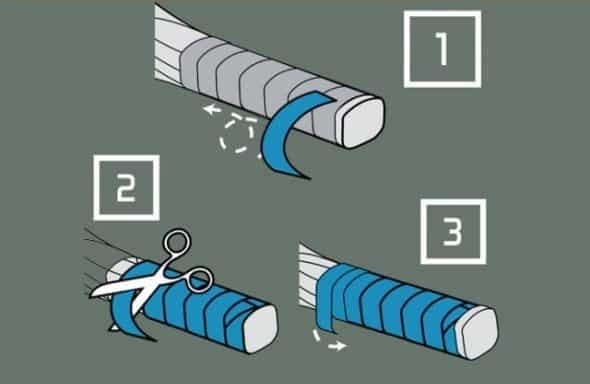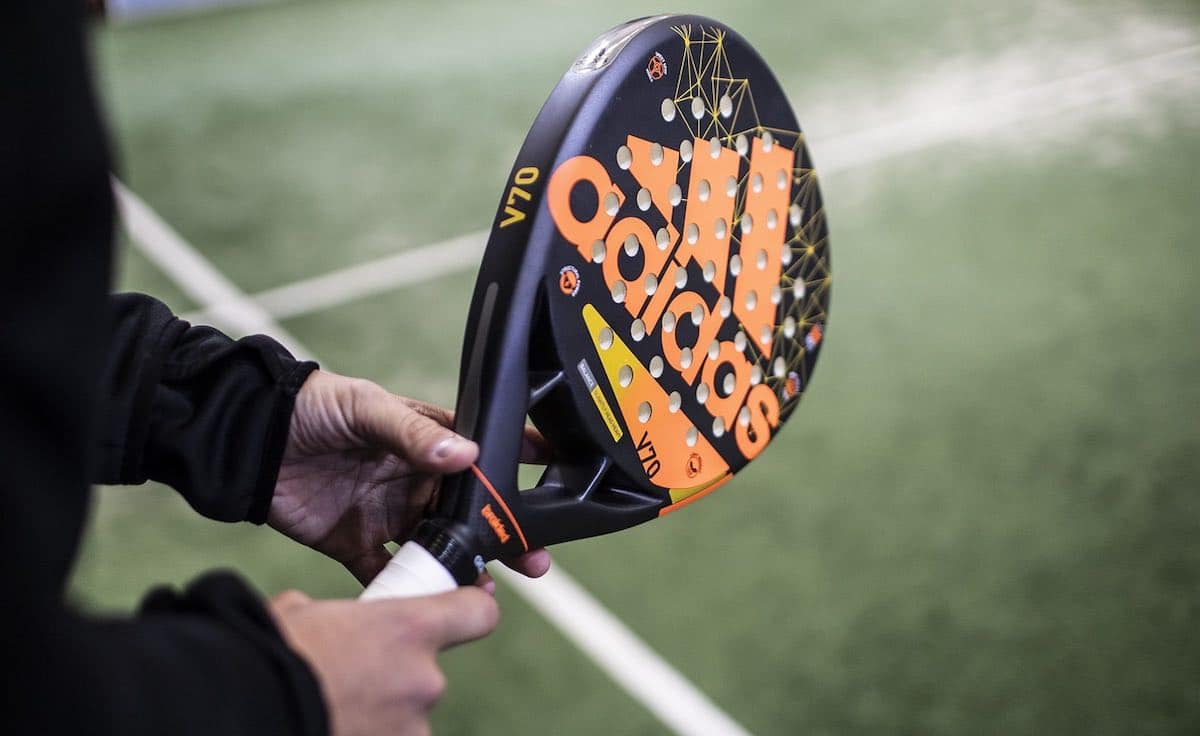Funnily enough, many padel players are beasts on the court with excellent skills and backhand serves — but they don’t know how to change padel overgrips.
It’s understandable, really. Because, in many cases, padel players don’t do it themselves. Or worse, they rarely replace them.
The use of grip sprays and gels is also becoming more common. We recommend the 4on totalgrip spray, it’s an incredible product.
Let’s change that today. You’ll start changing padel overgrips by yourself in no time and see the value of what a fresh padel grip can give you on the court!
Do you need any tools for putting on a grip on the padel racket?
The tools you need are your hands, internet access to watch YouTube tutorials, and scissors if you’re feeling fancy.
Jokes aside, you don’t need much when changing padel grips. If you want a neater job, a pair of scissors will be handy toward the end.
How to change your padel rackets overgrip

Let’s explain and break down the steps for changing your padel racquet grip. Trust us; you can do it in a few minutes!
- Rip off the current padel overgrip on the padel racket handle.
- Open the packet and bring out one roll of overgrip. (NOTE: you can purchase individual rolls or a whole pack in bulk; the latter is recommended for frequent players)
- Keep the small adhesive sticker that usually has the brand name (i.e., Wilson), as you’ll use it later.
- Unroll the grip bandage.
- Remove the plastic that’s covering the adhesive part. Some people forget to discard this.
- Look for the sticky thin end and start at the bottom-most part of the handle.
- Start wrapping the grip around the padel base and use your thumb to secure it.
- Wrap in overlaps if you want a thicker base, as some advanced players prefer.
- Work your way up as you cover the padel racket grip. For thinner grips, use a thinner layer. For thicker and more grip, overlap and add multiple layers of overgrip as desired.
- Cut the excess grip material using scissors (for a neater edge), or pull it off in one stroke with your hands when you reach the end of the racket grip.
- Tie the small adhesive sticker you kept earlier on end to secure the padel overgrip in place.
For our visual learners here, there are multiple videos online available, but you can watch this video tutorial from YouTube here:
What do I do if I’m not happy with the placement of my overgrip?
Minor mistakes in changing the padel overgrip are usually okay. It won’t affect your playing performance much, but you’ll feel a difference while hitting a shot.
Try using it with a continental grip, do some backhand strokes and forehand services, and hit a ball – how does it feel?
If it throws you off, it’s worth replacing the grip to avoid affecting your shots during the game. After all, these are inexpensive, and frequent changing is okay.
Just be sure to do it right this time! It’s still wasteful to throw away unused overgrips.
Why is a padel overgrip important?
Padel overgrips are beneficial to performance in multiple ways:
1. Increase comfort while you play padel
Comfort is vital in any sport, and padel is no different. You shouldn’t feel strained or distressed, so you can play better and have the correct stroke for perfect shots.
It also helps you catch the tension of the ball properly, allowing you to play with ease and feeling the sweet spot when you hit the ball.
2. Improve padel performance
As you may have learned in training, comfort is key to correct grip. It gives you more control when hitting the ball and even allows you to hit low balls and spin balls more accurately.
You’ll have improved playing performance, be it continental grip or forehand service, because you’re way more comfortable (which circles us back to benefit #1).
3. Avoid injuries
Poor padel grip can lead to injuries, with tennis elbow being the most common result of overworking the tendons on your arm and forehand.
You wouldn’t want to develop a tennis elbow, as it is painful and prevents you from playing. You’ll be required to rest.
The point of a great padel overgrip is to help you have the correct grip (or even a continental grip), so you won’t have to overwork yourself when hitting the ball.
Recommended reading:
The best padel rackets for tennis elbow (to avoid, or get rid of)
Conclusion
Changing a padel grip is easy. Plus, it’ll change how you play and improve every round.
This is also your reminder to change your padel overgrip regularly and impress everyone by upping your game via this small detail.
Frequently Asked Questions – How do you change a padel grip
First, rip off the existing overgrip on your padel racket. Start wrapping the thin end of the new one on the bottom-most part, and work your way up.
Simply cover the padel racket handle with the new grip by starting at the bottom and working your way up to the end of the handle. Fill in the gaps correctly and adjust according to your personal preference.
Don’t rush it to avoid misaligning the bandage. Use your fingers to secure every bit tight in place. Especially if it’s your first time, do the process slowly.
Change your padel grip as regularly as you can. It can be once a month or more if you have a game. Some players even change multiple times in one game. It’s also advisable to replace it if your grip is worn out, sweaty, and dirty.

Lucas Sánchez is the founder of SimplePadel. Born and raised in Spain, Lucas has been living in the US and UK for the last 20 years and currently calls Miami his home. While he’s never played professionally, the dream is still alive.
Lucas loves nothing more than playing (and talking) about padel, and he considers himself lucky to have a wife and family that share his love for the game.

4 replies on “How do you change a Padel Grip? (Quick Tutorial)”
[…] How to change your padel racket overgrip (tutorial) […]
[…] these, it’s vital to know how to change your padel grip as […]
[…] grip requires you to remove the ground winding of the padel racket, but you can add multiple overgrip layers for added support and still feel the grid as you […]
[…] How to change your Grip […]